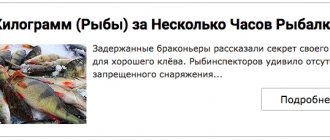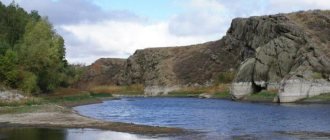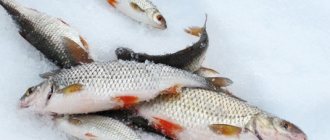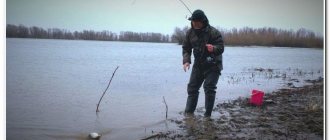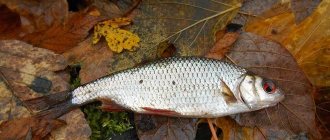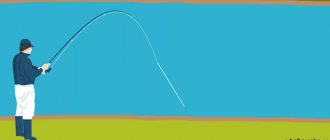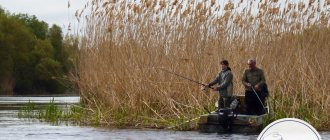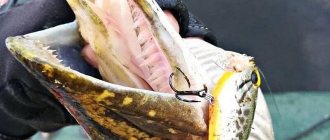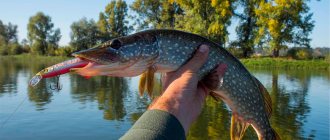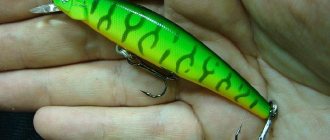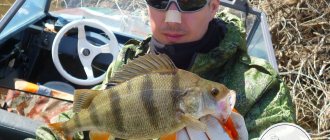Winter Fishing on the Volga 2020
A large predator, pike perch, is found throughout the European territory of Russia. The fanged robber can reach a mass of 20 kg with a length of 1.3 m. However, fishermen most often deal with individuals up to 0.5 m long and weighing up to 5 kg. Pike perch is caught in different ways. It bites well on live fish, as well as on a number of artificial baits. We'll show you in the video how to make catching pike perch with ratlins in winter effective.
In order for fishing for pike perch in winter to bring only pleasant impressions and a catch, you need to carefully prepare for catching this fish. It is important to know where pike perch live, understand its behavior, and what is best used as bait.
On the Dnieper
Winter fishing is good on the river and in the Smolensk region. Winter fishing on the Dnieper for pike, an activity that attracts many anglers. Even avid carp and bream fishermen. Pike is found where there are white fish, and the predator usually hunts for it. On the Dnieper you can catch stellate sturgeon, pike perch, sterlet, minnows and many other types of fish. The areas on the border with the Republic of Belarus are considered the most productive. In the Smolensk region, fishing is allowed all year round. Winter fishing on the Dnieper is characterized by the fact that the river has good depth differences at the bottom, this allows the fish to find a good winter road. This means that the catch in these pits will be good. This video is about fishing on the Dnieper:
Where does pike perch live in winter?
This fish is nocturnal. But it can also switch to a daytime lifestyle. Also, the non-standard features of this predator include its habit of hunting in the water column or on the surface of a reservoir, even though it is a bottom-dwelling fish. In winter, it most often lives on hard sand and gravel lake bottoms. But depending on the type of reservoir (river, lake, reservoir), the location of the fish may vary; this must be taken into account when going fishing for pike perch. In some bodies of water it can live in sandy and rocky dumps, in others in underwater snags, and somewhere among flooded and fallen trees. Read also: Catching pike perch with sprat in winter
In Siberia
Winter fishing in Siberia, namely on the Yenisei, is the dream of many fishermen. Trophy burbot, a fish worthy of attention. In winter, it is caught using a spoon with bait. Winter fishing on the Yenisei is carried out not only for burbot, but also for other fish. Taimen, lenok, peled, all these fish live in the Siberian River. In the area of the Sayano-Shushenskaya hydroelectric power station, the Yenisei is not covered with ice; grayling is caught there. Of course, in winter, it is easier to reach remote places by car. The ice in Siberia is strong and can withstand any type of transport. Video about fishing on the Yenisei:
What is most often used as bait for pike perch?
Spoon
Fans of catching pike perch in winter most often use spoons. But in order to choose this bait correctly, you need to take into account many nuances. The depth and strength of the current must be taken into account. For reservoirs, a spoon weighing no more than 20 grams is used. It is made of brass, copper and cupronickel. In those reservoirs where there is a strong current, the weight of the bait increases to 40-50 grams. This is interesting: The best winter lures for pike perch
Using a balancer
This fishing method is no less effective. To make the bait, a metal alloy resembling small fish is used. Additionally, such a bait can be mounted to the equipment: fastening is carried out by the eye, which is located on the back of the balancer. Then the bait is immersed in the bottom of the reservoir, and this imitates the natural food of pike perch. Read also: Top 10 Balancers for zander
Using a jig
It is also an interesting way to catch pike perch in winter. The only condition here is the size of the jig. It should be large due to the fact that the fish itself is quite large. Usually they use a “devil” jig in the form of a drop with a soldered hook. For additional bait, bait is used in the form of bloodworms or pieces of “live” fish.
The best time to catch predatory fish is clear and frosty weather. Especially in the morning and evening. But it’s also worth considering that pike perch is an unpredictable fish. That is, she may not have any interest in the bait for 24 hours, but then she suddenly becomes hungry in broad daylight. All this needs to be taken into account before you go hunting for walleye. This is interesting: Fishing with a balancer for pike perch in winter
On Pechora
Winter fishing in northern Russia involves fishing in hard-to-reach and uncrowded places. Anyone who has been there at least once will return again and again. Fishing on Pechora, in this harsh and beautiful region, reveals all the best qualities of a person. On Pechora they fish with a heavy jig, as the fast current carries away light baits. Of course, they catch grayling. The most favorite bait is a worm and bloodworms. It seems that the fish is ready to jump out of the water. For such fishing it is worth going to these places, which can only be reached by helicopter.
Catching pike perch with sprat in winter - fishing techniques and tactics
In winter, pike perch behaves very sluggishly and practically does not move around the reservoir. Now our task is to find promising areas and fish them. So we will have to walk a lot and drill a large number of holes, regardless of what equipment we use for catching pike perch with sprat in the winter (rod or girder)
It is advisable to initially study the bottom topography using a map, tips from the guard of the reservoir, and also an echo sounder.
The easiest way would be to sail a boat with an echo sounder in late autumn and enter data about promising areas into the navigator, or remember landmarks on the shore.
Fishing technique with a fishing rod:
- Having found an interesting area, we drill about ten to fifteen holes at a distance of 5-10 m from each other and begin fishing.
- We lower the rig with bait to the bottom;
- Raise it to a height of 20-30 cm when fishing in medium and strong currents and 40-50 cm in standing and low-flowing reservoirs;
- At this depth, we begin the game, making smooth rises with the fishing rod up to a height of 20-40 cm, alternating them with pauses. The length of pauses can be from several seconds to 1 minute. The more intense the bite, the shorter the pause and vice versa. Everything is the same as when catching pike perch in winter with a spoon .
- From time to time, instead of going up, you can lightly play with the fish in one place.
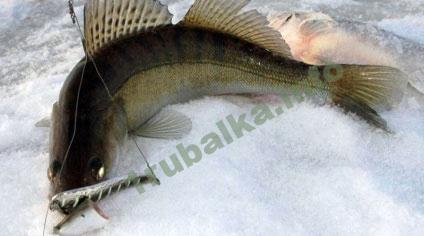
There are days when the pike perch behaves too passively and does not want to attack moving targets, so after drilling a series of holes, it is necessary to install two or three fishing rods with the expectation that the pike perch can bite on a non-moving bait. At the same time, we fish the remaining holes in parallel using the above method.
At the end of winter, fishing for pike perch using sprat can take place in different layers of water. The fact is that with warming, small fish become more active, in search of which the pike perch rises to the surface.
When fishing in the current, it is periodically worth giving the opportunity for the current to drag our bait a little, thereby covering a large area of water.
If one of the holes works, then the rod must be quickly re-equipped with a new sprat, since the pike perch stays in schools and there is a high probability of another bite from the catfish. Then, maintaining silence, drill several additional holes around the triggered hole at a distance of up to 1 meter.
Jerky fishing for pike perch using sprat in winter
At promising points, the girders can be placed in a checkerboard pattern or along a curved line. Arranging them along a curved line, we place the first girder at the beginning of the descent, and the subsequent ones as they deepen, so as to fish the entire slope. The piers are placed at intervals of 10-15 meters, so if the length of the slope is short, then we place one at the beginning, another in the middle and a third at the lowest point, making several rows.
Usually a fisherman needs 10 poles for normal fishing, but avid fishermen can take 20-30 poles with them.
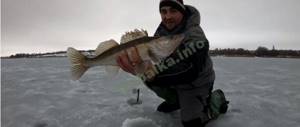
On a standing reservoir , the rig is loaded as follows: we wait until the equipment reaches the bottom, then we raise it to a height of 20-50 cm and fix the fishing line on the reel. Here it is necessary to take into account the size of the leash and set the depth so that the sprat is at a distance of 5-15 cm above the bottom level. Then we reel out the tackle, hook the sprat onto the hook, lower it back and insert a signal flag into the groove of the reel.
READ How to find out if there are crayfish in a pond
When fishing in current conditions , we immediately place the sprat on the hook and lower it to the bottom, remove the slack in the fishing line and fix the signal flag.
A straightened flag signals the activation of the vent. In this case, we approach it with maximum caution and without making unnecessary noise. There is no need to rush, especially since the pike perch needs to be given about a minute so that it swallows the bait normally and then we hook it.
Fishing on a balance beam
The balancer is very relevant for winter fishing for predatory fish. The movements of the bait contribute to the activation of the perch and effective bites. It is important to choose the right tactics here. You need to leave pauses between the up and down movements of the bait. While moving the bait, the fish looks closely at the prey. Then we leave the balancer motionless. Just at such a moment the perch swallows the hook.
I choose balancers measuring 4-6 cm. The colors include silver, acid, and “perch”.
Passive fish are picky. And at the moment of activity it goes for any colors and models of balancers.
There are a lot of fish in Astrakhan reservoirs, including, of course, perch. In order not to make a mistake and become the owner of luxurious trophies, I go to the Sazanya Bay base. There are fish there, and the conditions for winter fishing are comfortable. I get real pleasure from my old hobby.
TAGS:
Winter record. Pike perch on Ratlin video
Having seen enough photographs of large perches that Sergey Karpov successfully catches from the ice on a Jackall TN60 rattlin, Maxim Dubkovsky decided to go to the Saratov Reservoir himself with winter gear. Extreme weather conditions did not stop our anglers from catching perch and pike perch using different types of bait, and at the end of the trip Maxim got a real “bonus” that every fan of vertical pike perch can envy.
This is interesting: The best weather for fishing
In the Urals
Winter fishing in the Urals is varied and multifaceted. The Northern Urals are rivers where the best time is the months from February to March. At this time, grayling begins to become active. At this time, the river core is freed from ice, and grayling lives in areas under the ice. It is very difficult to get to it, because the thickness of the ice is already thin.
The Southern Urals are a lake region. In addition to bream, perch, pike perch, chebak, rotan is also caught there, a very scary-looking fish with tasty white meat. Video about winter fishing on the lakes of the Urals:
Fishing on the Volga
The Volga is the largest river in Europe. It is usually divided into upper, middle and lower parts. It passes through different climatic zones, so it has a wide variety of fish. Fishing in winter on the Volga begins along its entire length at different times. The ice rises earliest in the upper reaches, up to the source of the Oka. By mid-November, ice sets in the middle of the river from the Oka to the Kama, and only in December the section from the Kama to the Caspian Sea freezes. climatic conditions influence the catch. In the lower reaches it is richer and the weight of the fish is much greater.
Watch the video of how they catch fish in winter on the Volga:
At the beginning of December on the Volga you can catch large pike perch using live bait, and bream, pike or white fish using spoons. By mid-December, the ice becomes thicker. At this time, spinners with heavy balancers are used. You can catch catfish or pike perch with them.
When January frosts hit, the main rivers that have a current become ice-covered. On the Volga the ice becomes hummocks. This, of course, complicates the work of the ice drill and also interferes with the search for fishing spots. When catching white fish, it is very effective to use mesh feeders installed above winter fishing rods.
On Akhtuba
Winter fishing on Akhtuba, this is the region of Astrakhan in the lower reaches of the tributaries of the Akhtuba River, is very diverse. There are an abundance of ilmens, eriks, and small lakes. They are the first to be covered with ice and are a treasured place for anglers. The depth in them ranges from 0.5 to 5 meters. After, when the ice rises, you can get to the catchable places. First ice is the best time for a fisherman. Pike, perch, and pike perch are caught from the ice using girders.
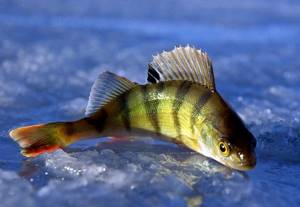
Winter perch fishing
If you are really excited about biting, you need to know that the ice around vegetation can be thin, so you need to be careful.
The pike perch, like a dog, chases RATTLIN. Underwater shooting. Winter fishing (Shcherbakov Brothers)
Inspired by the pike perch bites we filmed on the balance beam, a few days later we went to the same place, but with a high-resolution camera. Hurray, the pike perch remained in the same place, they didn’t go anywhere! At the same time, the fish was very active. While we were measuring the depth with a rattlin and fixing the fishing line, one of the pike perch had already begun hunting for bait. We didn't even notice it until the bite happened. At the same time, it was possible to film just a few attacks of the pike perch before it was hooked. These attacks lift the veil of mystery why pike perch, which are already close to the bait, do not bite as often as we fishermen would like... In the following videos we will show how pike perch react to conditionally silent rattlins, and whether the noise of a drill can scare pike perch.
Read also: Universal echo sounder for winter and summer fishing
Features of fishing on the first ice
Perch are incredibly active in the first few weeks after ponds freeze. Therefore, the predator is found during this period in areas near the shore, where the depth is very shallow.
During the period of severe, stable frosts, the water temperature decreases along with the oxygen level. Perch is losing activity. Large flocks are divided into small groups. Therefore, you can pull out the trophy anywhere in the reservoir. You can most likely find perch in the shallows, near the edges, and not far from ravines.
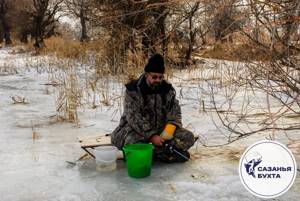
If there is bitter frost outside, the humpbacked predator goes deeper into pools and bottom holes.
Perch prefers such reservoirs where the remains of old trees and snags accumulate at the bottom. In thickets of aquatic vegetation, the predator waits for its prey.
Tackle for catching pike perch using sprat in winter
Fishing rod
We need a high-quality and powerful fishing rod 50-80 cm long with a hard carbon fiber whip and guide rings. The fishing rod handle should fit comfortably in the hand and be made of heat-saving materials such as wood or neopreon.
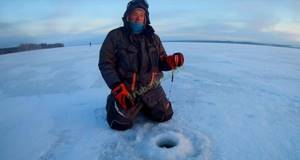
Coil
There are no special requirements, it all depends on the preferences of the fisherman. The simplest option is a large inertial reel with a friction brake, capable of holding about 35-40 meters of fishing line. A more expensive, but convenient option is a multiplier; you can also use small inertia-free reels with a spool size of about 1000 dai.
The most convenient, but at the same time expensive option for winter fishing is a multiplier reel; it is more convenient to use than a regular inertia reel with a friction clutch.
There are a number of fishermen who fish without using reels, fishing for prey exclusively with their hands; they put the simplest reels on the rod, which are needed only for winding and transporting the fishing line. True, in this case it is better to use a thicker fishing line, since you will be fishing without a clutch.
fishing line
Monofilament, the thickness depends on the size of the pike perch, 0.3 mm is considered the most optimal, for small pike perches 0.2-0.25 mm is enough, and for trophy pike perch, 0.35 mm may be needed. The thinner the line, the more effective it is to catch pike perch using sprat in winter, especially during the deep winter, but you should carefully calculate your strength and not over-fish.
On Baikal
Winter fishing on Lake Baikal is exciting and interesting. More than 50 species of fish are found on Lake Baikal. Famous fish: whitefish, grayling and the famous Baikal omul, found at depth. Pike, sorog, perch, and dace can be caught in shallow water. The catch of lucky fishermen on Lake Baikal can be taimen, which reaches up to 2 meters in length. There is also Baikal sturgeon there. Also a giant fish. The golomyanka fish, which lives at great depths, is considered very interesting . This is a viviparous fish, its transparent body consists of 35% fat.
This video is about fishing on Lake Baikal:
